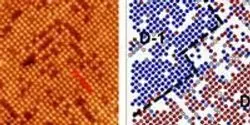All by Oak Ridge National Laboratory
Filter by
AllArticlesAudioEbooksEventsInfographicsNewsProductsSurveysDocumentsVideosVirtual EventsWebinars
Scientists at the Department of Energy’s Oak Ridge National Laboratory have used advanced microscopy to carve out nanoscale designs on the surface of a new class of ionic polymer materials for the first time. The study provides new evidence that atomic force microscopy, or AFM, could be used to precisely fabricate materials needed for increasingly smaller devices.

The U.S. Department of Energy’s (DOE) Oak Ridge Leadership Computing Facility (OLCF) has signed a contract with IBM to bring a next-generation supercomputer to Oak Ridge National Laboratory (ORNL). The OLCF’s new hybrid CPU/GPU computing system, Summit, will be delivered in 2017.

New methods are improving connections between private businesses and technology from the Department of Energy’s Oak Ridge National Laboratory, with 101 licenses and options executed during the last three years.

Researchers at the Department of Energy’s Oak Ridge National Laboratory are the first team to sequence the entire genome of the Clostridium autoethanogenum bacterium, which is used to sustainably produce fuel and chemicals from a range of raw materials, including gases derived from biomass and industrial wastes.

The High Flux Isotope Reactor, or HFIR, now in its 48th year of providing neutrons for research and isotope production at the Department of Energy’s Oak Ridge National Laboratory, has been designated a Nuclear Historic Landmark by the American Nuclear Society (ANS).

Recycled tires could see new life in lithium-ion batteries that provide power to plug-in electric vehicles and store energy produced by wind and solar, say researchers at the Department of Energy’s Oak Ridge National Laboratory.

A novel combination of microscopy and data processing has given researchers at the Department of Energy’s Oak Ridge National Laboratory an unprecedented look at the surface of a material known for its unusual physical and electrochemical properties.

Treating cadmium-telluride (CdTe) solar cell materials with cadmium-chloride improves their efficiency, but researchers have not fully understood why. Now, an atomic-scale examination of the thin-film solar cells led by the Department of Energy’s Oak Ridge National Laboratory has answered this decades-long debate about the materials’ photovoltaic efficiency increase after treatment.

Anasys Instruments Corp. has licensed a Department of Energy Oak Ridge National Laboratory technology that allows for simultaneous chemical and physical characterization and could lead to advances in materials and drug development.














